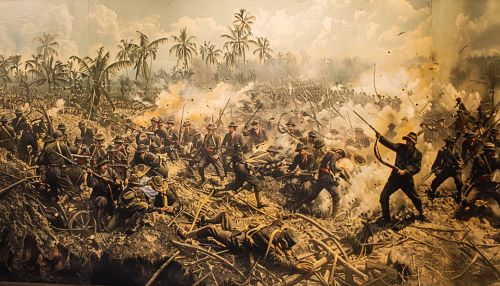Philippine–American War
Background
The Philippine–American War, also known as the Philippine War of Independence or the Philippine Insurrection, was an armed conflict between the United States and Filipino revolutionaries that took place from 1899 to 1902. The war was a continuation of the Philippine Revolution against Spanish rule, which was interrupted by the Spanish-American War.


Causes
The primary cause of the Philippine-American War was the struggle of the Filipino people for independence after more than three centuries of Spanish colonial rule. The United States, which had defeated Spain in the Spanish-American War, had acquired the Philippines as part of the Treaty of Paris. The U.S. decision to retain control of the Philippines was met with widespread opposition from Filipino revolutionaries led by Emilio Aguinaldo, who had declared the Philippines' independence in June 1898.
Course of the War
The war officially began on February 4, 1899, when an American soldier, Private William Grayson, shot a Filipino soldier in Manila. This incident, known as the Battle of Manila, marked the beginning of a brutal and bloody conflict that would last for more than three years.
The war was characterized by conventional and guerrilla warfare. The Filipino forces, lacking in resources and formal military training, resorted to guerrilla tactics to combat the well-equipped American forces. The Battle of Tirad Pass and the Battle of Mabitac are notable examples of the Filipinos' guerrilla warfare.
Impact and Aftermath
The Philippine-American War resulted in significant casualties on both sides. An estimated 20,000 Filipino combatants were killed, and more than 200,000 Filipino civilians died, mostly due to famine and disease. On the American side, more than 4,000 soldiers were killed.
The war ended with the capture of Emilio Aguinaldo by American forces in March 1901. However, sporadic resistance continued until 1902, when U.S. President Theodore Roosevelt declared the war officially over.
The war had profound implications for both the Philippines and the United States. For the Philippines, it marked the beginning of American colonial rule, which would last until 1946. For the United States, the war marked its emergence as a global power.
Legacy
The Philippine-American War remains a controversial topic in both countries. In the Philippines, the war is remembered as a heroic struggle for independence. In the United States, the war is often overshadowed by the Spanish-American War and is seen as a dark chapter in American history.
See Also
Philippine Revolution Spanish-American War Emilio Aguinaldo Theodore Roosevelt
